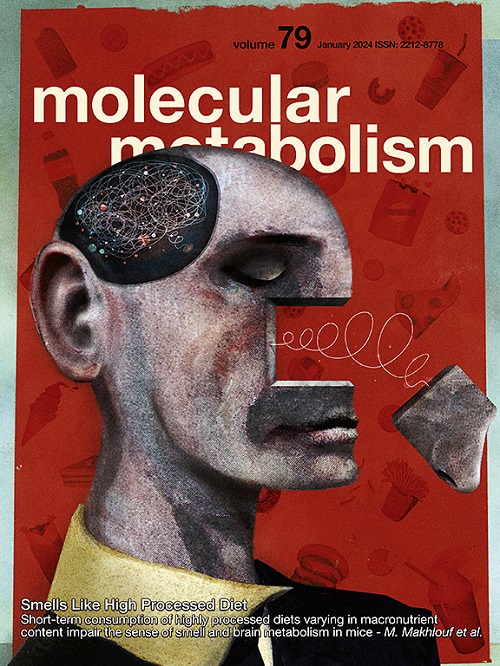Kynurenic acid derived from mesentery regulates mesenteritis and colitis via inducing white adipose browning in Crohn’s disease
IF 7
2区 医学
Q1 ENDOCRINOLOGY & METABOLISM
引用次数: 0
Abstract
Objective
Hypertrophied mesenteric adipose tissue (MAT) wrapped around the inflamed intestine, also known as creeping fat (CrF), is a classic pathological characteristic of Crohn’s disease (CD). Recent studies revealed that the abnormal mesentery in CD exhibits a white-to-beige transformation (known as white adipose browning), which may be a compensatory mechanism for disease attenuation. However, its underlying causes and mechanisms remain unknown.
Methods
The beige MAT samples from patients with CD and normal white MAT samples from patients without CD were collected, and targeted metabolome analysis was performed. Interleukin-10 gene knockout (IL-10−/−) and 2,4,6-trinitrobenzenesulphonic acid solution (TNBS)-induced colitis mice were used to evaluate the effects of kynurenic acid (KYNA) on mesenteritis and colitis. Mesenteric explants and adipocytes were collected and cultured to assess the effects of KYNA on adipose tissue browning and macrophage inflammation.
Results
Targeted metabolomic sequencing revealed that KYNA exhibited the highest level of upregulation in the beige MAT of CD, which was tightly correlated with the browning marker UCP-1, inflammatory factors, and adipokines. In vivo experiments demonstrated that KYNA triggered the white-to-beige transformation of MAT in IL-10−/− and TNBS-induced colitis mice, which further alleviated mesenteritis and colitis. Additionally, mesenteric explants and adipocytes displayed a browning phenotype with KYNA co-incubation, and their supernatants significantly induced M2 macrophage polarization and inhibited inflammation. Mechanistically, KYNA induced MAT browning and regulated disease procession of CD via GPR35-ERK1/2-PGC-1α signaling pathway.
Conclusions
This study provides novel insights into the browning transformation of the mesentery in CD and suggests a potential approach for clinical therapy.

来源于肠系膜的犬尿酸通过诱导克罗恩病的白色脂肪褐变调节肠系膜炎和结肠炎。
背景:肠系膜脂肪组织(MAT)包裹在发炎的肠道周围,也称为蠕动脂肪(CrF),是克罗恩病(CD)的典型病理特征。最近的研究表明,乳糜泻的异常肠系膜呈现白色到米色的转变(称为白色脂肪褐变),这可能是疾病衰减的代偿机制。然而,其根本原因和机制尚不清楚。方法:收集CD患者米色MAT样本和非CD患者正常白色MAT样本,进行针对性代谢组分析。采用白细胞介素-10基因敲除(IL-10-/-)和2,4,6-三硝基苯磺酸溶液(TNBS)诱导结肠炎小鼠,研究犬尿酸(KYNA)对肠系膜炎和结肠炎的影响。收集肠系膜外植体和脂肪细胞进行培养,观察KYNA对脂肪组织褐变和巨噬细胞炎症的影响。结果:靶向代谢组学测序显示,KYNA在CD的米色MAT中表现出最高水平的上调,这与褐变标志物UCP-1、炎症因子和脂肪因子密切相关。体内实验表明,KYNA在IL-10-/-和tnbs诱导的结肠炎小鼠中触发了MAT从白色到米色的转化,进一步缓解了肠系膜炎和结肠炎。此外,在KYNA共孵育下,肠系膜外植体和脂肪细胞呈现褐变表型,其上清液显著诱导M2巨噬细胞极化,抑制炎症。机制上,KYNA通过GPR35-ERK1/2-PGC-1α信号通路诱导MAT褐变,调控CD的发病过程。结论:本研究为乳糜泻肠系膜褐变提供了新的见解,并为临床治疗提供了潜在的途径。
本文章由计算机程序翻译,如有差异,请以英文原文为准。
求助全文
约1分钟内获得全文
求助全文
来源期刊

Molecular Metabolism
ENDOCRINOLOGY & METABOLISM-
CiteScore
14.50
自引率
2.50%
发文量
219
审稿时长
43 days
期刊介绍:
Molecular Metabolism is a leading journal dedicated to sharing groundbreaking discoveries in the field of energy homeostasis and the underlying factors of metabolic disorders. These disorders include obesity, diabetes, cardiovascular disease, and cancer. Our journal focuses on publishing research driven by hypotheses and conducted to the highest standards, aiming to provide a mechanistic understanding of energy homeostasis-related behavior, physiology, and dysfunction.
We promote interdisciplinary science, covering a broad range of approaches from molecules to humans throughout the lifespan. Our goal is to contribute to transformative research in metabolism, which has the potential to revolutionize the field. By enabling progress in the prognosis, prevention, and ultimately the cure of metabolic disorders and their long-term complications, our journal seeks to better the future of health and well-being.
 求助内容:
求助内容: 应助结果提醒方式:
应助结果提醒方式:


